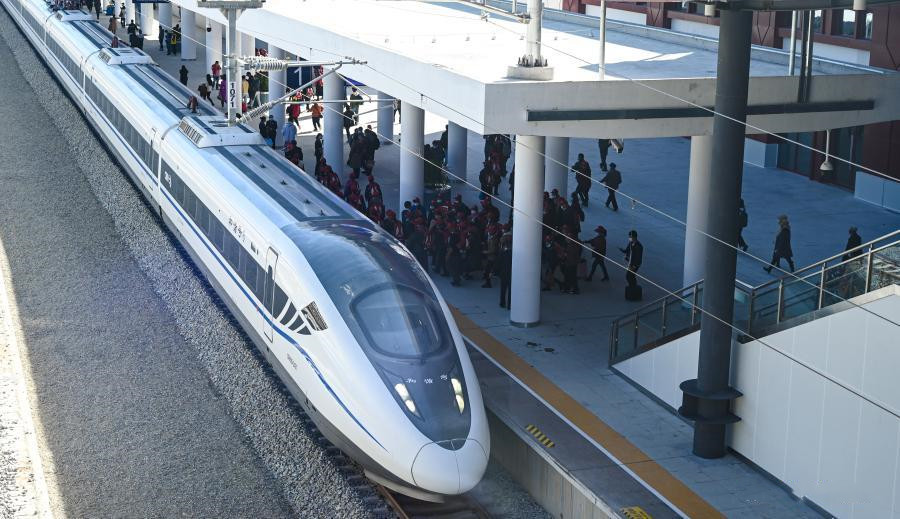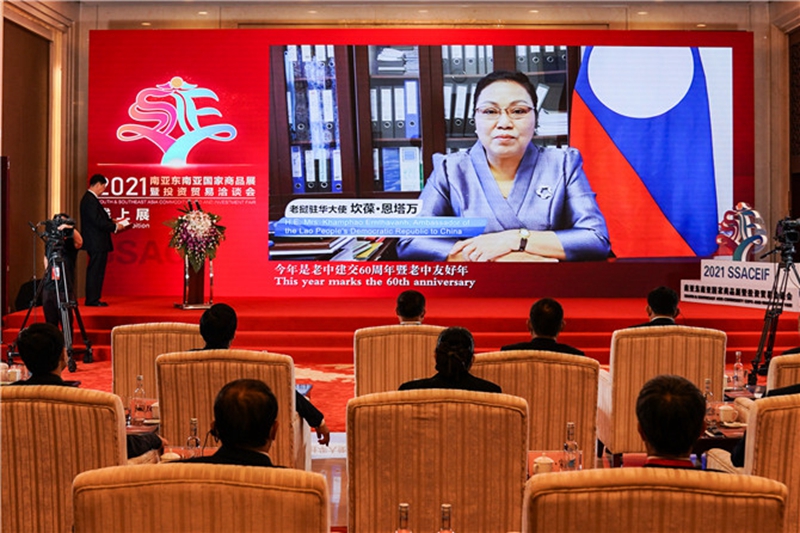Eric's Insight: Yunnan progress, prospect to be pivot of opening-up
When my fellow folks and I in northeast Yunnan’s mountains wanted to leave home for the provincial capital of Kunming city in early 2000s, we would plan the long journey for days in advance, hesitating over the means of transport: by coach or by coach plus train?
If we chose coach, the fare for each person would be around RMB 200 and the coach ride usually lasted for around 20 hours to cover the 300km country road. And if we took a coach to the neighboring Guizhou province and transferred to a Liupanshui-Kunming train, the fare sum was cheaper -- around RMB 150, but the journey was probably longer for delays at the Liupanshui train station.
Having worked in Kunming for two years, I got acquainted in 2010 with Xiaomei from southwest Yunnan’s Lincang city that borders Myanmar. Back then, it took me around ten hours to travel to the border city to meet her and coach was the only transport means available.
Since taking office in 2012, Chinese President Xi Jinping has paid two inspection visits to Yunnan, during which he positioned the province as China’s new pivot of opening-up facing south and southeast Asia and expected Yunnan to make new progress in this regard.
Following President Xi Jinping’s visits to Yunnan in 2015 and in 2020, the province has been working hard to take its expected role as China’s new pivot of opening-up. Both my hometown and Lincang have been linked to Kunming by high-speed rail, and now both Xiaomei and I can reach the provincial capital in a matter of three hours.
Here, I’d like to first sum up what Yunnan achieved in opening-up and then look into future possibilities for the province to better fulfill its mission.

Passengers board a bullet train to Kunming city at Lincang Railway Station, southwest Yunnan province, Dec. 30, 2020. (Xinhua/Wang Guansen)
Achievement in multiple fields
Yunnan province has achieved a lot in taking its role as China’s new pivot of opening-up over the years, focusing on policy coordination, facility connectivity, financial integration, and much more.
In policy coordination, the province has aligned its development plans with the Mekong countries and beyond, with its collaboration with Laos, Thailand and Maldives deepened. It forged 103 sister-city partnerships with 36 countries, standing out among Chinese provinces in the number of partnerships with south and southeast Asian countries.
In facility connectivity, Yunnan linked up the Chinese provinces with Laos and other neighbors via the China-Laos railway, and the province has upgraded the Chinese section of the China-Vietnam railway to standard gauge.
Construction of the Chinese section of China-Myanmar Railway is making headway, with the border city Lincang already included into the Chinese railway network. And the China-Myanmar new transport mode that involved road, rail and water has begun container services.
Yunnan has opened air routes to most south and southeast Asian capitals and tourist destinations, and it also fueled regional economy through the China-Myanmar oil and gas pipeline. It’s also linked to parts of Vietnam, Laos and Myanmar via international power grid.
In trade facilitation, the province's foreign trade has continued to grow over the past ten years, with the international trade volume increasing from 132.59 billion yuan in 2012 to 314.38 billion yuan in 2021, an annual growth of 11%.
Yunnan actually utilized USD 888 million in foreign capital in 2021, an increase of 17.07%, while its provincial FDI reached USD 1.024 billion, up by 40.27%. In financing, Yunnan’s cross-border RMB business continues to expand.
As of June 2022, the province's cross-border RMB settlement amount has accumulated to 689.295 billion yuan, and cross-border RMB business has presence in 106 countries/regions, covering all south and southeast Asian nations that have established diplomatic relations with China.
The first RMB-Thai baht change post was launched in the market. Two Vietnamese Dong direct cash supply platforms and the first Thai baht direct cash supply platform were set up in Yunnan. Cash transportation between China and Laos has been in service.
People-to-people bonds between Yunnan and the south and southeast Asian countries have been getting closer in terms of education, tourism, Covid fight and more. Yunnan doctors carried out free surgeries for cataract patients in Myanmar, Cambodia and beyond.
By running a Yoga school for Yoga majors, Yunnan Minzu University has frequented its civil contacts with India. Yunnan University of Finance and Economics and the Thailand-based Rangsit University have been jointly offering business programs to international students in the region.
Yunnan artists have staged multiple performances in the ASEAN and south Asian countries, and the province has joined hands with the countries in setting up 10 laboratories, 14 national scientific bases and 69 provincial technological centers.

Laotian Ambassador to China Khamphao Ernthavanh speaks at the 2021 South and Southeast Asia Commodity Expo and Investment Fair (SSACEIF). (Yunnan Daily/Zhang Cheng)
Pioneer for neighborhood diplomacy?
Looking into the future, Yunnan needs to bring its strategic location into fuller play for faster growth, seeking more policy support from the central government and further joining hands with the neighboring provinces in southwest China. In doing so, it can surely take its role as the Chinese pivot of opening up to south and southeast Asia, and potentially become the pioneer for China’s neighborhood diplomacy.
The basic assumption for Yunnan to be the Chinese pivot of opening up to south and southeast Asia lies in its strategic location. In the era of reversing globalization, the neighborhood diplomacy has become more crucial than ever for China.
Among the Chinese provinces, Yunnan is probably the most relevant to neighborhood diplomacy, given its direct link to the three ASEAN nations of Myanmar, Laos and Vietnam, as well as its proximity to Thailand, Bangladesh, east India and Nepal.
Xinjiang and Xizang also border multiple countries of central and south Asia, but given the nations’ GDP, population size and others factors that determine the potential to be a global power house in the future, the central Asian countries are arguably less important than those in south Asia or southeast Asia, ASEAN and India in particular.
However, Yunnan is strategically located in that the province substantially borders continental southeast Asia, while neighboring south Asia. If neighborhood diplomacy matters to China in the current international political landscape, Yunnan should be the first province to be considered. In terms of population, the UN says India will soon surpass China to be the most populous country in the world, and its potential to be a global power is almost conspicuous.
In a recent speech delivered in Thailand, the Indian minister of external affairs Subrahmanyam Jaishankar mentioned the idea of “Asian Century” coined by late Chinese leader Deng Xiaoping decades ago, saying the Asian century will be possible only when China and India come together. By the same token, Yunnan is expected to play a more active role in communication with India and other neighboring countries when appropriate.
Currently, China-India relations have yet gone beyond the shadows of border conflicts over the past years. With the Indian participation into the US-designed QUAD security dialogue and the IPEF economic framework, the Indian-US army showing muscle near the China-India LoC and the Indian diplomats speaking poorly to their Chinese counterparts in Sri-Lanka, it seems not to be the right timing for Yunnan to get closer to India.
Believe it or not, the provincial effort to take its role as Chinese pivot of opening up is bound to be affected by the general air of China-India relations, the border rows in particular.
To better fulfill its role, the province need to be better tuned its actions with the China-India diplomacy, asking for more policy and financial support from the national government and the developed coastal areas.
Back to the 1980s and 1990s, the western provinces supported the special economic zones in east and south China. Now the developed Chinese areas could help Yunnan and other western Chinese provinces to further open up.
Also, Yunnan needs to join hands with its neighboring Chinese provinces in interaction with S&SE Asian countries. The Chinese provinces with interest in south and southeast Asia may include Guangxi, Sichuan, Guizhou, Chongqing and even Xizang and Xinjiang.

The 2022 International Yoga Day & China-India Cultural Exchange Event takes place in Kunming, Yunnan province on June 21. (Photo/Yunnan Daily)
(The writer Eric Wang Shixue is an English editor with the Mekong News Network based in Kunming, Yunnan province. The view in the article does not necessarily represent that of Yunnan Gateway.)








